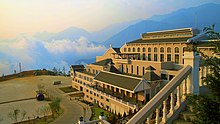
Back Turisme i Vietnam Danish Tourismus in Vietnam German Turismo en Vietnam Spanish Tourisme au Viêt Nam French ვიეტნამის ტურიზმი Georgian ទេសចរណ៍ប្រទេសវៀតណាម Cambodian 베트남의 관광 Korean Pelancongan di Vietnam Malay Turismo no Vietnã Portuguese Туризм во Вьетнаме Russian








Tourism in Vietnam is a component of the modern Vietnamese economy. In 2019, Vietnam received 18 million international arrivals, up from 2.1 million in the year 2000. The Vietnam National Administration of Tourism is following a long-term plan to diversify the tourism industry, which brings foreign exchange into the country.[1]
Tourist arrivals in Vietnam have continued to rise in recent years. In 2008, Vietnam received 4.218 million international tourists, in 2009 the number was 3.8 million, down 11%. In 2012, Vietnam received 6.84 million tourists.[2] This was a 13% increase from 2011 figure of 6 million international visitors, which was itself a rise of 2 million visitors relative to 2010 arrivals. In 2016, Vietnam welcomed 10 million international visitors which represented a 26% increase from the previous year.[3][4] In 2019, Vietnam with 18 million international visitors was the fifth most visited country in the Asia-Pacific region as per the World Tourism rankings released by the United Nations World Tourism Organization.[5]
- ^ Vietnam country profile. Library of Congress Federal Research Division (December 2005). This article incorporates text from this source, which is in the public domain.
- ^ TITC. "Vietnam National Administration of Tourism". Retrieved 11 June 2015.
- ^ "International visitors to Vietnam in December and 12 months of 2011". Vietnam National Administration of Tourism. Archived from the original on 20 July 2014. Retrieved 26 January 2012.
- ^ "Statistics for 2010". General Statistics Office. Retrieved 26 January 2012.
- ^ "UNWTO World Tourism Barometer and Statistical Annex, December 2020 | World Tourism Organization". UNWTO World Tourism Barometer (English Version). 18 (7): 1–36. 18 December 2020. doi:10.18111/wtobarometereng.2020.18.1.7. S2CID 241989515.
© MMXXIII Rich X Search. We shall prevail. All rights reserved. Rich X Search